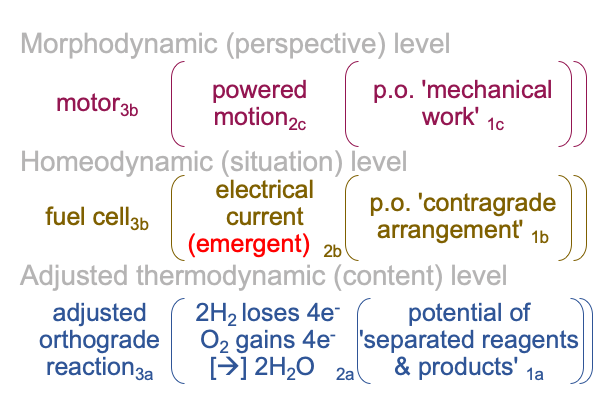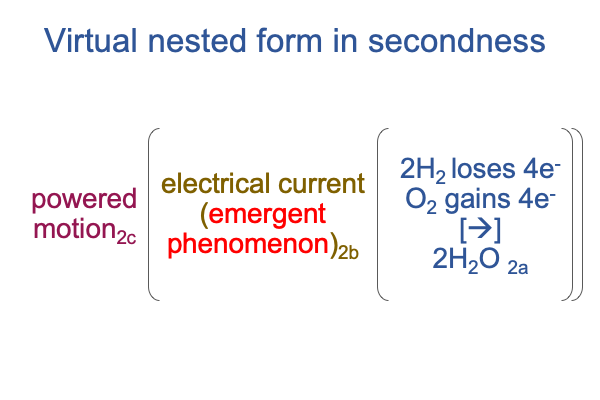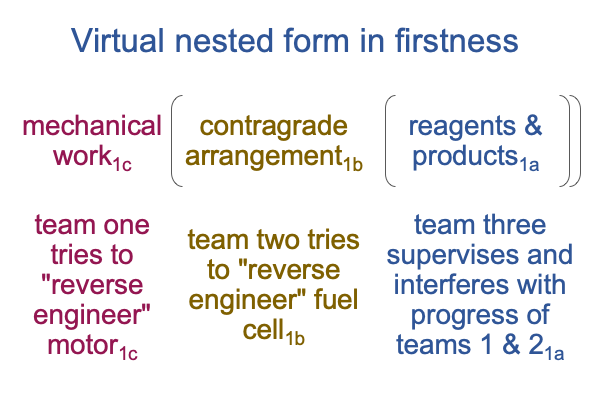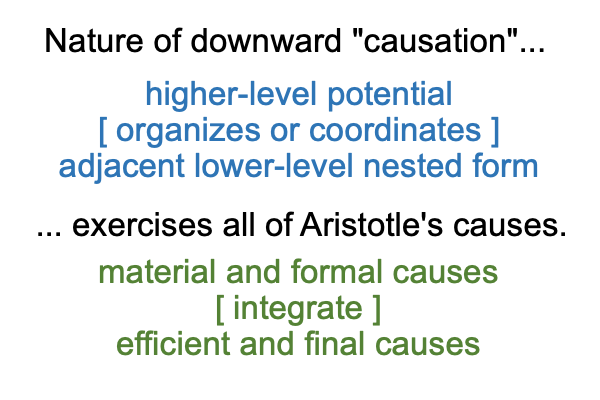0097 Chapter two is titled, “Metaphysical Challenges for Emergence and Downward Causation”.
Once again, here is my human-designed example for an emergent phenomena: the hydrogen-oxygen fuel cell.

0098 Notice that the thermodynamica level has been adjusted3a to account for the situational potential of a contragrade arrangement1b, giving the appearance of downward causation.
In a similar manner, the fuel cell3b design may be honed to maximize the potential of mechanical work1c.
So, “downward causation” is the label applied when the potential of a higher level influences the normal context of adjacent lower level.
0099 Now, for a thought experiment. Let me say that a motor powered by a hydrogen fuel-cell is made by corporation A and falls into the hands of corporation B, which would like to… um… “reproduce” the technology, in order to not be purchased outright by the profitable corporation A.
What falls into the hands of corporation B?
A fuel-cell powers a motor.

0100 The motor goes off to be analyzed by one technical team.
The fuel cell goes off to be analyzed by a second technical team.
0101 Funny, there are two “appearances of downward causation” and corporation B assigns two technical teams to the one project. Plus, corporation B assigns a third team to coordinate the two technical teams. Philosophers are assigned to this team.
Here is a picture.

0102 Here is how team one sees the problem.
The motor is material. What are the materials? The motor efficiently converts electrical current into mechanical work. What are the efficient causes? The motor is made by corporation A. Is that an efficient cause or a final cause? Who knows? Well, we know that its a motor. And what is the purpose of this motor? Better ask team three.
0103 Here is how team two sees the challenge.
The fuel cell is material. What are the materials? The fuel cell produces an emergent phenomenon, an electric current, by separating the oxidation of molecular hydrogen from the reduction of molecular oxygen. The technology is advanced, since the cathode (the hydrogen side) and the anode (the oxygen side) are specially designed as instruments for this purpose. The materials touch base with the formal cause. The formal cause is the generation of electricity. We suspect that the free-energy of the overall chemical reaction is captured as an electric current, because that fits the fuel-cell’s design. Design goes with formal causes.
How do we know for sure? Ask team three.
0104 Here is how team three sees the challenge.
We need our spies in corporation A to tell us what specifically this device is designed to do (formal cause) as well as for what overall purpose (final cause).
0105 Tabaczek, who seeks to introduce Aristotle’s four causes from his own, natural philosophical point of view, regards the activities of the three teams at work in corporation B, as they are reflected in the mirror of theology.
He asks, “Where do I see Aristotle’s four causes in emergence and downward causation?”
After all, this is precisely what the three teams in corporation B seem to be dealing with. The electrical current is an emergent phenomenon that powers a motor for unknown purposes. The potential of each higher level of analysis orders the configuration of the adjacent lower level analysis. Can that be called, “downward causation”?
Of course! But, if someone in team three tries to figure out the material, efficient, final and formal causation, that person is faced with two implied hylomorphes.

0106 Plus, the contiguities in Peirce’s secondness may range far and wide, but they all touch base with Aristotle’s exemplar, matter [substantiates] form, as foundational icon. The terms, “coordinate” and “integrate” take on the characteristic of “causes”, broadly defined as a contiguity between two real elements.
A scientist would like to simplify all this into one hylomorphe: material causes [integrate] efficient causes. The causes that matter are physical. The causes that form are reductive (that is, the higher-level potential is merely a manifestation of the adjacent lower-level nested form). The scientist’s preference is called “reductive physicalism”.
0107 The metaphysicians say, “Whoa, that is a step too far. The implied hylomorphes are both real and account for the existence of team three, which employs us.”
They label the two implied hylomorphes, “nonreductive physicalism”, in order to articulate their disagreement.
Articulate their disagreement?
Labels are important.
“Reductive physicalism” shoehorns emergence into modern truncated efficient and material causations.
“Nonreductive physicalism” acknowledges that final and formal causes cannot simply be cut out of the scientific analysis.
Note the compromise.
Typically, the term, “physicalism”, elevates modern truncated material and efficient causations.
These metaphysicians want to remain on the science side of Tabaczek’s mirror.
That is where the money is.
